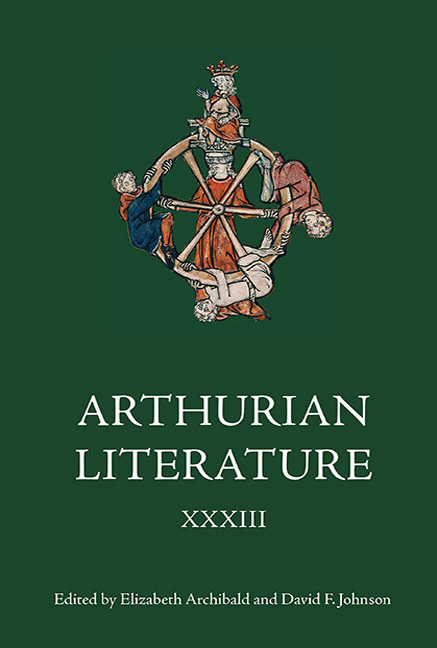Book contents
- Frontmatter
- Contents
- General Editors’ Foreword
- Contributors
- I From ‘The Matter of Britain’ to ‘The Matter of Rome’: Latin Literary Culture and the Reception of Geoffrey of Monmouth in Wales
- II ChrÉtien's British Yvain in England and Wales
- III Edward III's Abandoned Order of the Round Table Revisited: Political Arthurianism after Poitiers
- IV ‘Thanked Be God There Hath Been But A Few Of Myne Auncytours That Hathe Dyed In Their Beddes’: Border Stories and Northern Arthurian Romances
- V T. H. White's Representation of Malory's Camelot
- VI The Old Knight An Edition of the Greek Arthurian Poem of Vat. Gr. 1822
- Miscellaneous Endmatter
- Commentary
- Contents of Previous Volumes
III - Edward III's Abandoned Order of the Round Table Revisited: Political Arthurianism after Poitiers
Published online by Cambridge University Press: 29 July 2017
- Frontmatter
- Contents
- General Editors’ Foreword
- Contributors
- I From ‘The Matter of Britain’ to ‘The Matter of Rome’: Latin Literary Culture and the Reception of Geoffrey of Monmouth in Wales
- II ChrÉtien's British Yvain in England and Wales
- III Edward III's Abandoned Order of the Round Table Revisited: Political Arthurianism after Poitiers
- IV ‘Thanked Be God There Hath Been But A Few Of Myne Auncytours That Hathe Dyed In Their Beddes’: Border Stories and Northern Arthurian Romances
- V T. H. White's Representation of Malory's Camelot
- VI The Old Knight An Edition of the Greek Arthurian Poem of Vat. Gr. 1822
- Miscellaneous Endmatter
- Commentary
- Contents of Previous Volumes
Summary
After the capture of Jean II of France (r. 1350–64) at Poitiers on 19 September 1356, Edward III of England (r. 1327–77) found himself in a diplomatic quandary. How could he negotiate a peace treaty with (and demand a kingly ransom for) Jean II without undermining his claim to the throne of France? With reference to the Florentine chronicle of Matteo Villani (d. 1363) and the chronicle of ‘Anonymous of Canterbury’ (1346–65), I shall demonstrate that Edward's solution was to fashion himself after King Arthur once again and that this course of action is the most probable cause of the historiographical conflation of Edward III's abandoned Order of the Round Table, which had been developed between January and November 1344, and the Order of the Garter, which was established in its place approximately five years later. According to the Galfridian chronicle tradition, Arthur was a king of kings and France was one of the many realms under his yoke. Edward, by likening himself to Arthur, conveyed that he too should be seen as suzerain of France and that Jean had become his vassal. Moreover, the outcome of the battle of Poitiers presented Edward III with an opportunity to revive his Arthurian image. The victory had been a decisive one in which his army had the opportunity and martial discipline to capture (rather than to kill) forty-two of the leading lords of France (including the king of France himself) and a further 1,933 men-at-arms. If, as I have argued previously, the total-war tactics employed by the English at Crécy in 1346 were contrary to Arthurian ideals and made Arthur a problematic paradigm for Edward III (especially at the time of the institution of the Garter), the outcome of Poitiers made Arthur again an appealing model.
The very idea that Edward III resumed Arthurian self-fashioning after Poitiers is contrary to the prevailing scholarly opinion, which rests uncomfortably on tentative conclusions drawn by Roger Sherman Loomis in 1939. In order to demonstrate the significance of my new findings, I shall begin by explaining the state of scholarship on the matter.
- Type
- Chapter
- Information
- Arthurian Literature XXXIII , pp. 70 - 109Publisher: Boydell & BrewerPrint publication year: 2016



